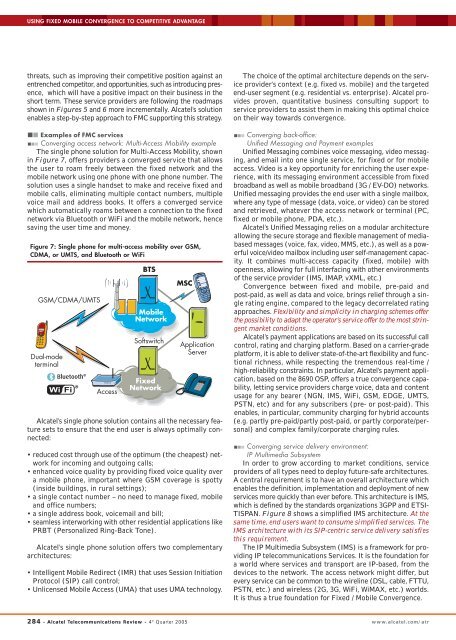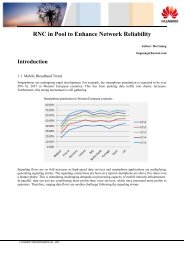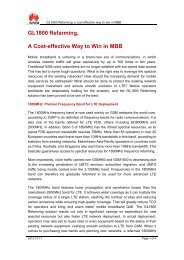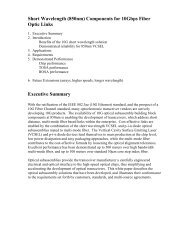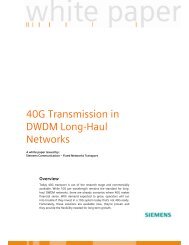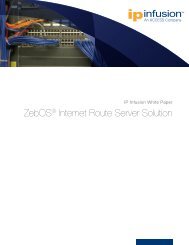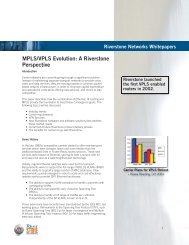report - Light Reading
report - Light Reading
report - Light Reading
You also want an ePaper? Increase the reach of your titles
YUMPU automatically turns print PDFs into web optimized ePapers that Google loves.
USING FIXED MOBILE CONVERGENCE TO COMPETITIVE ADVANTAGE<br />
threats, such as improving their competitive position against an<br />
entrenched competitor, and opportunities, such as introducing presence,<br />
which will have a positive impact on their business in the<br />
short term. These service providers are following the roadmaps<br />
shown in Figures 5 and 6 more incrementally. Alcatel’s solution<br />
enables a step-by-step approach to FMC supporting this strategy.<br />
Examples of FMC services<br />
Converging access network: Multi-Access Mobility example<br />
The single phone solution for Multi-Access Mobility, shown<br />
in Figure 7, offers providers a converged service that allows<br />
the user to roam freely between the fixed network and the<br />
mobile network using one phone with one phone number. The<br />
solution uses a single handset to make and receive fixed and<br />
mobile calls, eliminating multiple contact numbers, multiple<br />
voice mail and address books. It offers a converged service<br />
which automatically roams between a connection to the fixed<br />
network via Bluetooth or WiFi and the mobile network, hence<br />
saving the user time and money.<br />
Figure 7: Single phone for multi-access mobility over GSM,<br />
CDMA, or UMTS, and Bluetooth or WiFi<br />
GSM/CDMA/UMTS<br />
Dual-mode<br />
terminal<br />
Access<br />
BTS<br />
Mobile<br />
Network<br />
Softswitch<br />
Fixed<br />
Network<br />
MSC<br />
Application<br />
Server<br />
Alcatel’s single phone solution contains all the necessary feature<br />
sets to ensure that the end user is always optimally connected:<br />
• reduced cost through use of the optimum (the cheapest) network<br />
for incoming and outgoing calls;<br />
• enhanced voice quality by providing fixed voice quality over<br />
a mobile phone, important where GSM coverage is spotty<br />
(inside buildings, in rural settings);<br />
• a single contact number – no need to manage fixed, mobile<br />
and office numbers;<br />
• a single address book, voicemail and bill;<br />
• seamless interworking with other residential applications like<br />
PRBT (Personalized Ring-Back Tone).<br />
Alcatel’s single phone solution offers two complementary<br />
architectures:<br />
• Intelligent Mobile Redirect (IMR) that uses Session Initiation<br />
Protocol (SIP) call control;<br />
• Unlicensed Mobile Access (UMA) that uses UMA technology.<br />
The choice of the optimal architecture depends on the service<br />
provider’s context (e.g. fixed vs. mobile) and the targeted<br />
end-user segment (e.g. residential vs. enterprise). Alcatel provides<br />
proven, quantitative business consulting support to<br />
service providers to assist them in making this optimal choice<br />
on their way towards convergence.<br />
Converging back-office:<br />
Unified Messaging and Payment examples<br />
Unified Messaging combines voice messaging, video messaging,<br />
and email into one single service, for fixed or for mobile<br />
access. Video is a key opportunity for enriching the user experience,<br />
with its messaging environment accessible from fixed<br />
broadband as well as mobile broadband (3G / EV-DO) networks.<br />
Unified messaging provides the end user with a single mailbox,<br />
where any type of message (data, voice, or video) can be stored<br />
and retrieved, whatever the access network or terminal (PC,<br />
fixed or mobile phone, PDA, etc.).<br />
Alcatel’s Unified Messaging relies on a modular architecture<br />
allowing the secure storage and flexible management of mediabased<br />
messages (voice, fax, video, MMS, etc.), as well as a powerful<br />
voice/video mailbox including user self-management capacity.<br />
It combines multi-access capacity (fixed, mobile) with<br />
openness, allowing for full interfacing with other environments<br />
of the service provider (IMS, IMAP, vXML, etc.)<br />
Convergence between fixed and mobile, pre-paid and<br />
post-paid, as well as data and voice, brings relief through a single<br />
rating engine, compared to the legacy decorrelated rating<br />
approaches. Flexibility and simplicity in charging schemes offer<br />
the possibility to adapt the operator’s service offer to the most stringent<br />
market conditions.<br />
Alcatel’s payment applications are based on its successful call<br />
control, rating and charging platform. Based on a carrier-grade<br />
platform, it is able to deliver state-of-the-art flexibility and functional<br />
richness, while respecting the tremendous real-time /<br />
high-reliability constraints. In particular, Alcatel’s payment application,<br />
based on the 8690 OSP, offers a true convergence capability,<br />
letting service providers charge voice, data and content<br />
usage for any bearer (NGN, IMS, WiFi, GSM, EDGE, UMTS,<br />
PSTN, etc) and for any subscribers (pre- or post-paid). This<br />
enables, in particular, community charging for hybrid accounts<br />
(e.g. partly pre-paid/partly post-paid, or partly corporate/personal)<br />
and complex family/corporate charging rules.<br />
Converging service delivery environment:<br />
IP Multimedia Subsystem<br />
In order to grow according to market conditions, service<br />
providers of all types need to deploy future-safe architectures.<br />
A central requirement is to have an overall architecture which<br />
enables the definition, implementation and deployment of new<br />
services more quickly than ever before. This architecture is IMS,<br />
which is defined by the standards organizations 3GPP and ETSI-<br />
TISPAN. Figure 8 shows a simplified IMS architecture. At the<br />
same time, end users want to consume simplified services. The<br />
IMS architecture with its SIP-centric service delivery satisfies<br />
this requirement.<br />
The IP Multimedia Subsystem (IMS) is a framework for providing<br />
IP telecommunications Services. It is the foundation for<br />
a world where services and transport are IP-based, from the<br />
devices to the network. The access network might differ, but<br />
every service can be common to the wireline (DSL, cable, FTTU,<br />
PSTN, etc.) and wireless (2G, 3G, WiFi, WiMAX, etc.) worlds.<br />
It is thus a true foundation for Fixed / Mobile Convergence.<br />
284 - Alcatel Telecommunications Review - 4 th Quarter 2005 www.alcatel.com/atr


